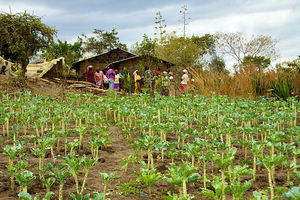Kale is a leafy green member of the cabbage family. It is closer related to wild cabbage, which grows in a bunch of leaves around a central stock, than it is to domestic cabbage found in grocery stores. The delicious and nutritious green is also genetically similar to broccoli, cauliflower, collard greens, and Brussels’s sprouts. Two varieties of kale are most common in the United States. These are green curly kale and lacinato kale, also called dinosaur kale. It is a hearty leafy green full of nutrients and health benefits. For optimal nutrition eat kale raw and organic.
Kale is rich in the phytochemical lutein. Lutien is known to help prevent cancer and eye disease. Rich in vitamins, one cup of kale contains as much vitamin C as an orange, and it is a good source of vitamin A which is essential for immune function. The calcium content in kale is as high as the calcium content in cow’s milk. Unlike spinach and chard, kale contains no oxalic acid. Oxalic acid prevents the body from absorbing the calcium in greens. Since the calcium in kale is available to the body, kale is a protective force against osteoporosis, arthritis, and bone loss. In addition, kale helps to ward off heart disease, regulate blood pressure, and has anti-inflammatory qualities.
Kale has many benefits for women and mothers. It helps balance estrogen, and wards off certain cancers that afflict women. Pregnant women can benefit from the rich supply of folic acid found in kale, as it is essential to the development of a baby’s nervous system while in utero. Along with other leafy greens, kale increases breast milk supply.
Kale is widely available year-round. When shopping for kale, look for crisp fresh green leaves. It can be kept in a bag, container, or vegetable crisper for up to one week. Eat kale whole in salads or blend it into a fruit smoothie for a nutritious boost. Try kale in a stir-fry or in a healthy steamed vegetable combination.
Sources:
http://en.wikipedia.org/wiki/Kale
http://www.vegfamily.com/whole-family/kale.htm




